The NVIDIA GeForce GTX 1650 Super Review, Feat. Zotac Gaming: Bringing Balance To 1080p
by Ryan Smith on December 20, 2019 9:00 AM ESTPower, Temperature, & Noise
Last, but not least of course, is our look at power, temperatures, and noise levels. While a high performing card is good in its own right, an excellent card can deliver great performance while also keeping power consumption and the resulting noise levels in check.
| GeForce Video Card Voltages | |||||
| 1650S Max | 1660 Max | 1650S Idle | 1660 Idle | ||
| 1.05v | 1.05v | 0.65v | 0.65v | ||
If you’ve seen one TU116 card, then you’ve seen them all as far as voltages are concerned. Even with this cut-down part, NVIDIA still lets the GTX 1650 Super run at up to 1.05v, allowing it to boost as high as 1950MHz.
| GeForce Video Card Average Clockspeeds | ||||
| Game | GTX 1660 | GTX 1650 Super | GTX 1650 | |
| Max Boost Clock | 1935MHz | 1950MHz | 1950MHz | |
| Boost Clock | 1785MHz | 1725MHz | 1695MHz | |
| Shadow of the Tomb Raider | 1875MHz | 1860MHz | 1845MHz | |
| F1 2019 | 1875MHz | 1875MHz | 1860MHz | |
| Assassion's Creed: Odyssey | 1890MHz | 1890MHz | 1905MHz | |
| Metro: Exodus | 1875MHz | 1875MHz | 1860MHz | |
| Strange Brigade | 1890MHz | 1860MHz | 1860MHz | |
| Total War: Three Kingdoms | 1875MHz | 1890MHz | 1875MHz | |
| The Division 2 | 1860MHz | 1830MHz | 1800MHz | |
| Grand Theft Auto V | 1890MHz | 1890MHz | 1905MHz | |
| Forza Horizon 4 | 1890MHz | 1875MHz | 1890MHz | |
Meanwhile the clockspeed situation looks relatively good for the GTX 1650 Super. Despite having a 20W lower TDP than the GTX 1660 and an official boost clock 60MHz lower, in practice our GTX 1650 Super card is typically within one step of the GTX 1660. This also keeps it fairly close to the original GTX 1650, which boosted higher in some cases and lower in others. In practice this means that the performance difference between the three cards is being driven almost entirely by the differences in CUDA core counts, as well as the use of GDDR6 in the GTX 1650 Super. Clockspeeds don’t seem to be a major factor here.
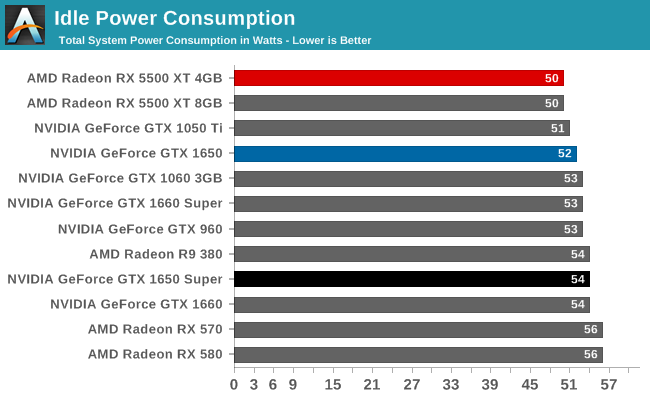
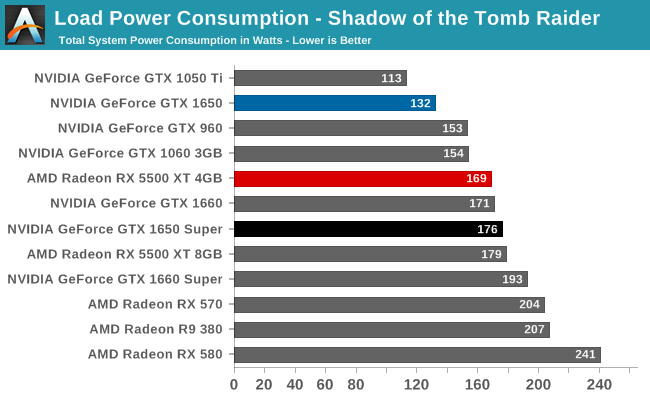
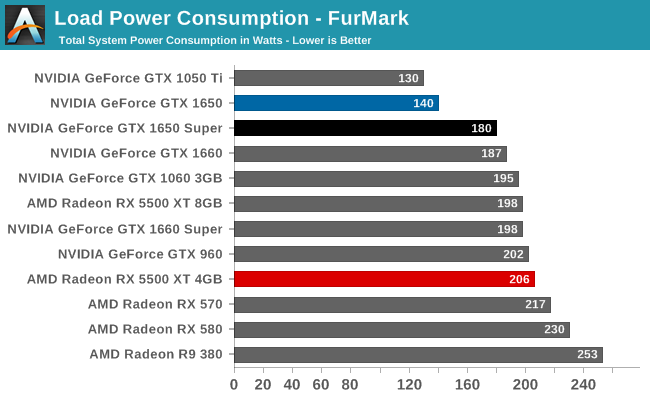
Shifting to power consumption, we see the cost of the GTX 1650 Super’s greater performance. It’s well ahead of the GTX 1650, but it’s pulling more power in the process. In fact I am a bit surprised by just how close it is (at the wall) to the GTX 1660, especially under Tomb Raider. While on paper it has a 20W lower TDP, in practice it actually fares a bit worse than the next level TU116 card. It’s only under FurMark, a pathological use case, that we see the GTX 1650 Super slot in under the GTX 1660. The net result is that the GTX 1650 Super seems to be somewhat inefficient, at least by NVIDIA standards. It doesn’t save a whole lot of power versus the GTX 1660 series, despite the lower performance.
Which also means it doesn’t fare especially well against the Radeon RX 5500 XT series. As with the GTX 1660, the RX 5500 XT is drawing less power than the GTX 1650 Super under Tomb Raider. It’s only by maxing out all of the cards with FurMark that the GTX 1650 Super pulls ahead. In practice I expect real world conditions to be between these two values – Tomb Raider may be a bit too hard on these low-end cards – but regardless, this would put GTX 1650 Super only marginally ahead of RX 5500 XT.
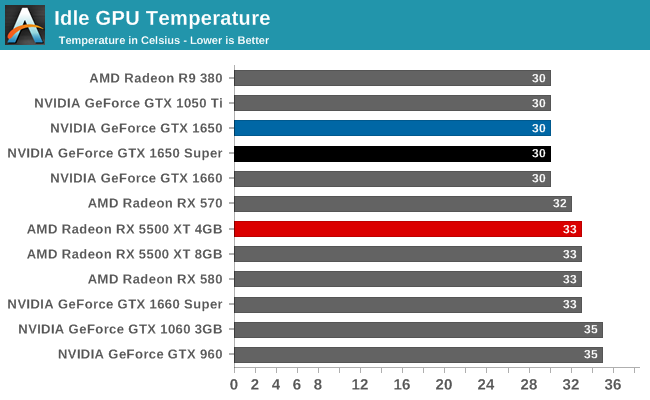
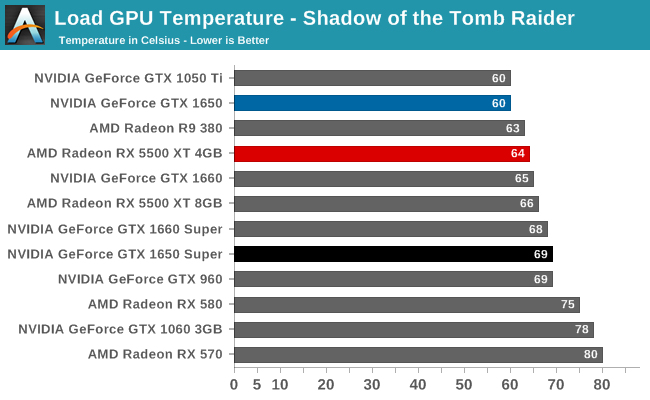
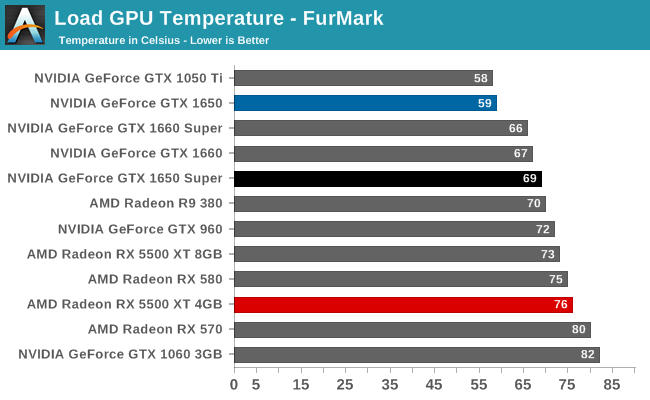
Looking at GPU temperatures, Zotac’s GTX 1650 Super card puts up decent numbers. While the 100W card understandably gets warmer than it’s 75W GTX 1650 sibling, we never see the GPU temperatures cross 70C. The card is keeping plenty cool.
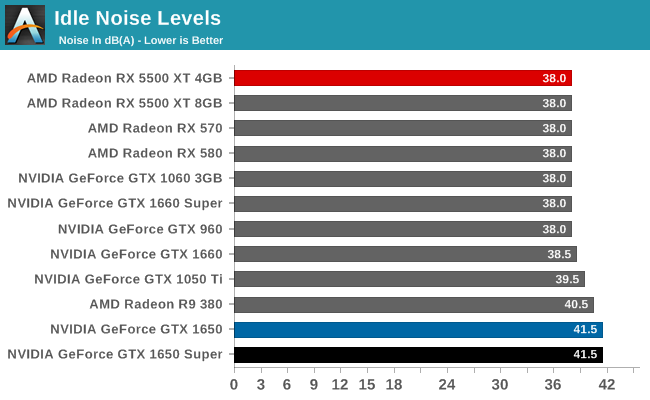
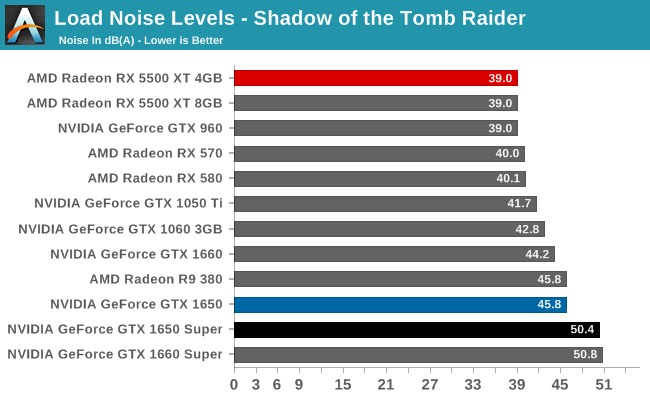
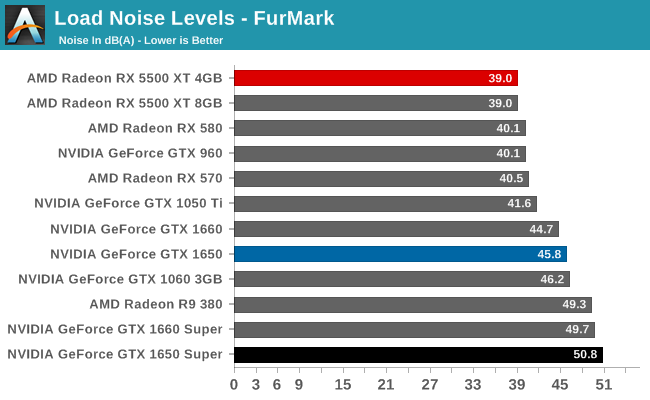
But when it comes time to measure how much noise the card is producing, we find a different picture. In order to keep the GPU at 69C, the Zotac GTX 1650 Super’s fans are having to do some real work. And unfortunately, the small 65mm fans just aren’t very quiet once they have to spin up. To be sure, the fans as a whole aren’t anywhere near max load – we recorded just 55% as reported by NVIDIA’s drivers – however this is still enough to push noise levels over 50 dB(A).
Zotac’s single-fan GTX 1650 card didn’t fare especially well here either, but by the time we reach FurMark, the GTX 1650 Super does even worse. It’s louder than any GTX 1660 card we’ve tested, even marginally exceeding the GTX 1660 Super.
All of this makes for an interesting competitive dichotomy given last week’s launch of the Radeon RX 5500 XT. The card we test there, Sapphire’s Pulse RX 5500 XT, is almost absurd in how overbuilt it is for a 130W product, with a massive heatsink and equally massive fans. But it moves more heat than Zotac’s GTX 1650 Super with a fraction of the noise.
If nothing else, this is a perfect example of the trade-offs that Sapphire and Zotac made with their respective cards. Zotac opted to maximize compatibility so that the GTX 1650 Super would fit in virtually any machine that the GTX 1650 (vanilla) can fit in, at the cost of having to use a relatively puny cooler. Sapphire went the other direction, making a card that’s hard to fit in some machines, but barely has to work at all to keep itself cool. Ultimately neither approach is the consistently better one – despite its noise advantage, the Sapphire card’s superiority ends the moment it can’t fit in a system – underscoring the need for multiple partners (or at least m multiple board designs). Still, it’s hard to imagine that Zotac couldn’t have done at least a bit better here; a 50 dB(A) card is not particularly desirable, especially for as something as low-powered as a GTX 1650 series card.










67 Comments
View All Comments
Marlin1975 - Friday, December 20, 2019 - link
Little disappointing. Lower performance than a 580 and higher priced than others in its price range.If the price was quiet a bit lower then it might make a decent HTPC card for some.
HarryVoyager - Friday, December 20, 2019 - link
The 8Gb 580's, both new and used, are going to be the elephant in the room for a while I suspect. A reasonably cared for miner card runs only $100 and will keep you going at least until AMD is competitive enough to drive nVidia's pricing down.Yojimbo - Friday, December 20, 2019 - link
A reasonably cared for mining card...? How do you assure that?The 580s have been so cheap because AMD made too many of them. Nvidia are not so interested in low end market share. They'll sell cards there if they can make money on them. I have a feeling GDDR6 dram has come down in price in the last year more than 7 nm fabrication cost has. Now they can sell in that market segment with good profits.
Retycint - Friday, December 20, 2019 - link
I would imagine most miners run their cards undervolted/underclocked for maximum efficiency. And it's a 24/7 load, unlike the periodic low->high->low load of gaming cards, which is actually better for the card in the long run. So miner cards actually tend to be in better condition (save for the fans, of course).But then again, there's the risk of miner cards that have had modded BIOSes installed which might have damaged the card? So I suppose it's down to buying from a reputable seller
Yojimbo - Friday, December 20, 2019 - link
They would have undervolted and then pushed it to get the most performance they could without crashes and run it 24/7. It would be sitting in a hot case in a hot room. I don't think it's a particularly desirable card. But my question is actually in response to what your conclusion was: How do we judge a mining card? What do you mean a reputable seller? A 3rd party that picked up the card fro some miner?PeachNCream - Saturday, December 21, 2019 - link
GPU mining was typically done with open air brackets rather than in a densely packed case. However, GPU mining is a lot less commonplace these days given the low profitability. We are past that being a thing really so finding a modern ex-miner GPU is not as easy of a prospect as it was even a couple of years ago.Kangal - Saturday, December 21, 2019 - link
The thing is Mining Cards really are Gaming Cards.There's less than 1% performance and thermal difference between the two. Even Linus TechTips did an experiment on this by comparing a mining card that was used for 4 years constantly, compared to the exact same card (same variant) which was still sealed in the box. No difference.
At worst case scenario, the used card is not going to have warranty, and you may need to "refurbish" it yourself: clean the case, clean the innards, reapply thermal paste, put in new fans. All up it's going to cost you $5-$20. So when you're saving yourself $50-$100 it's worth it, from a value point.
MamiyaOtaru - Sunday, December 22, 2019 - link
nobody thinks there is a performance difference between an ex mining card and a new card. Performance doesn't do a slow fade. The worry is that the mining card could be that much closer to failure.Kangal - Sunday, December 22, 2019 - link
Actually, heaps of people think mining cards run hotter, use more power, and run slower compared to Brand New. It's actually a very widespread misconception.Mining cards being closer to failure is actually a myth as well. If the card is running relatively normally when you buy it, a quick refurb will bring it back to New condition. The same applies to a Gaming Card, if you hear the fans are out of tune: replace fans. If it's running hotter than normal: reapply thermal paste. If it looks dusty: clean the innards and casing.
As was pointed out, Gaming Cards are usually at Idle, then at Maximum Performance, then Idle, then Max again. That process is actually harsher on the components: fan, tim, logic board, and uneven heat dissipation. A Mining Card is usually run cooler and at lower voltage, and its running smoothly and consistently which doesn't cause as much "micro-cracks" in the thermal paste, or the fan assembly. Not to mention, I think subjectively miners are likely to look after their hardware a little better (it's making $) and used in open air, there's some merit to it.
However, this stigma has been good for enthusiasts for generating a lot of great mining cards at stupid low prices. The old AMD HD7970, I've seen them go for $50 like 5 years ago. The AMD R9 290, was around $150 as well. Now, we've got plenty of ex-mining RX 470 and RX 580's, that's really killing it for people considering a RX 5500XT or GTX 1660. (Un)fortunately there wasn't too many Vega56 or Vega64 cards manufactured to affect the market too much. The Nvidia cards have seemed to keep their value much better (GTX 980, GTX 1070, etc).
MASSAMKULABOX - Friday, January 3, 2020 - link
Some mining cards had NO video outputs .. a slight handicap for gaming ?Mining cards were in general looked after well ..but home miners ..not so much...
quite a lot of the miners factored in th resale value of the cards ,, the prices were high new, so s/h prices would also be high. Only when everyone wants to sell their cards at the same time prices drop.